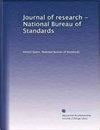Applications of the Reaction Interface/Mass Spectrometer Technique to the Analysis of Selected Elements and Nuclides from Submicrogram Quantities of Biological Macromolecules and Xenobiotics
Journal of research of the National Bureau of Standards
Pub Date : 1988-06-01
DOI:10.6028/jres.093.102
引用次数: 7
Abstract
Markey and Abramson [1] developed a microwave-powered chemical reaction interface, a device which converts a complex organic molecule in the presence of a reactant gas into small stable molecules which are detected by mass spectrometry. For a given reactant gas the molecules formed are a representation of the elemental composition of the original anlayte. The combination of the reaction interface and a mass spectrometer produces an isotopeor element-selective detector for samples either introduced directly into the reaction interface or flowing from a capillary gas chromatograph column. Microgram and submicrogram samples of a variety of proteins were analyzed for their sulfur content relative to their carbon content by introducing the samples directly into the reaction interface. With CO, as the reactant gas, S02 at m/z 64 is produced. This quantifies the amount of sulfur which was introduced into the reaction interface. In the presence of N2, HCN at m/z 27 is produced and is used to quantify the carbon content of the sample. The observed ratio of S/C for various proteins correlated well with the elemental formulas [2]. In the presence of S02, 4NO at m Iz 30 and 5NO at m/z 31 are produced. Following administration of 50 mg of triple-labeled 5,5-diphenylhydantoin (1, 3("N); 2('C)] to a male beagle dog, a urine sample was selectively analyzed for its 15N content by capillary gas chromatography-reaction interface/ mass spectrometry. The corrected ratio of m/z 31 to m/z 30 produced a highly selective chromatogram showing only peaks of '5N enrichment. Mass spectra of these peaks were obtained which Alkylation of DNA In Vivo: Development of Analytical Methodology for Trace Quantitative Analysis反应界面/质谱仪技术在亚微克级生物大分子和异种生物中选定元素和核素分析中的应用
Markey和Abramson开发了一种微波驱动的化学反应界面,这种装置可以将存在反应物气体的复杂有机分子转化为可以通过质谱检测的稳定小分子。对于给定的反应物气体,所形成的分子代表了原始分析物的元素组成。反应界面和质谱仪的结合产生了一个同位素或元素选择性检测器,用于直接进入反应界面或从毛细管气相色谱仪柱流出的样品。通过将样品直接引入反应界面,分析了各种蛋白质的微克和亚微克样品相对于碳含量的硫含量。以CO为反应物气体,生成m/ z64的so2。这量化了进入反应界面的硫的量。在N2存在下,生成m/z 27处的HCN,用于定量样品的碳含量。观察到的各种蛋白质的S/C比值与元素式[2]有很好的相关性。在S02的存在下,在m/z 30产生4NO,在m/z 31产生5NO。在给药50mg三标记的5,5-二苯肼(1,3(“N);2('C)]对一只雄性beagle犬的尿液样本,采用毛细管气相色谱-反应界面/质谱法选择性分析其15N含量。修正后的m/ z31和m/ z30的比值产生了高度选择性的色谱图,只显示了'5N的富集峰。这些峰的质谱由《体内DNA的烷基化:痕量定量分析方法的发展》获得
本文章由计算机程序翻译,如有差异,请以英文原文为准。
求助全文
约1分钟内获得全文
求助全文

 求助内容:
求助内容: 应助结果提醒方式:
应助结果提醒方式:


